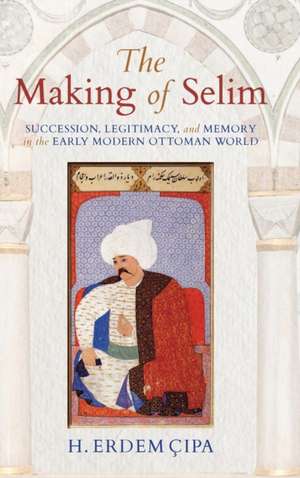The Making of Selim – Succession, Legitimacy, and Memory in the Early Modern Ottoman World
Autor H. Erdem Cipaen Limba Engleză Hardback – 27 feb 2017
| Toate formatele și edițiile | Preț | Express |
|---|---|---|
| Paperback (1) | 233.94 lei 6-8 săpt. | |
| MH – Indiana University Press – 27 feb 2017 | 233.94 lei 6-8 săpt. | |
| Hardback (1) | 456.82 lei 6-8 săpt. | |
| MH – Indiana University Press – 27 feb 2017 | 456.82 lei 6-8 săpt. |
Preț: 456.82 lei
Preț vechi: 593.28 lei
-23% Nou
Puncte Express: 685
Preț estimativ în valută:
87.41€ • 91.51$ • 72.33£
87.41€ • 91.51$ • 72.33£
Carte tipărită la comandă
Livrare economică 05-19 aprilie
Preluare comenzi: 021 569.72.76
Specificații
ISBN-13: 9780253024237
ISBN-10: 0253024234
Pagini: 436
Dimensiuni: 159 x 236 x 33 mm
Greutate: 0.82 kg
Editura: MH – Indiana University Press
ISBN-10: 0253024234
Pagini: 436
Dimensiuni: 159 x 236 x 33 mm
Greutate: 0.82 kg
Editura: MH – Indiana University Press
Notă biografică
H. Erdem Cipa is Assistant Professor of Ottoman History at the University of Michigan, Ann Arbor. He is author of Yavuz'un Kavgasi: I. Selim'in Saltanat Mücadelesi and editor (with Emine Fetvaci) of Writing History at the Ottoman Court: Editing the Past, Fashioning the Future.
Cuprins
Acknowledgements
Note on Transliteration
Introduction
Part One: The Making of a Sultan
1. Politics of Succession: Selim's Path to the Throne
2. Politics of Factions
Part Two: The Creation of Selim's Composite Image
Part Two Introduction: A Historiographical Survey
3. Selim, The Legitimate Ruler
4. Selim, The Idealized Ruler
5. Selim, The Divinely Ordained Ruler
Conclusion
Bibliography
Index
Note on Transliteration
Introduction
Part One: The Making of a Sultan
1. Politics of Succession: Selim's Path to the Throne
2. Politics of Factions
Part Two: The Creation of Selim's Composite Image
Part Two Introduction: A Historiographical Survey
3. Selim, The Legitimate Ruler
4. Selim, The Idealized Ruler
5. Selim, The Divinely Ordained Ruler
Conclusion
Bibliography
Index
Descriere
In death, Selim continued to serve the empire, becoming represented in ways that reinforced an idealized image of Muslim sovereignty in the early modern Eurasian world.









